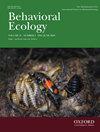Are weapon allometries steeper in major or minor males? A meta-analysis
IF 2.2
3区 环境科学与生态学
Q2 BEHAVIORAL SCIENCES
引用次数: 0
Abstract
Competition for mates can drive the evolution of exaggerated weaponry and male dimorphism associated with alternative reproductive tactics. In terrestrial arthropods, male dimorphism is often detected as non-linear allometries, where the scaling relationship between weapon size and body size differs in intercept and/or slope between morphs. Understanding the patterns of non-linear allometries is important as it can provide insights into threshold evolution and the strength of selection experienced by each morph. Numerous studies in male-dimorphic arthropods have reported that allometric slopes of weapons are shallower in large “major” males compared to small “minor” males. Because this pattern is common among beetles that undergo complete metamorphosis (holometabolous), researchers have hypothesized that the slope change reflects resource depletion during pupal development. However, no comprehensive survey has examined the generality of this trend. We systematically searched the literature for reports of weapon allometries in male dimorphic species and conducted a phylogenetically controlled meta-analysis to explore the factors influencing the difference in slopes between morphs. Our search identified 59 effect sizes from 19 studies, 50 species, and 5 orders of terrestrial arthropods. We found strong evidence that metamorphosis type influences the patterns of weapon allometries. Slopes were significantly steeper in minor males compared to major males in holometabolous species, but there was no difference in slopes between morphs in hemimetabolous species (i.e., those that undergo incomplete or no metamorphosis). These results support the hypothesis that holometabolous species face a resource ceiling during pupal development that limits the exaggeration of weapon size.主要男性还是次要男性的武器异构体更陡峭?荟萃分析
对配偶的竞争会推动与其他生殖策略相关的夸张武器装备和雄性二态性的进化。在陆生节肢动物中,雄性二态通常表现为非线性异形,即不同形态之间武器大小与体型之间的比例关系在截距和/或斜率上有所不同。了解非线性异构的模式非常重要,因为它可以让我们深入了解阈值进化和每种形态所经历的选择强度。对雄性二态节肢动物的大量研究表明,与小型 "次要 "雄性动物相比,大型 "主要 "雄性动物的武器异速斜率较浅。由于这种模式在完全变态(全代谢)的甲虫中很常见,研究人员假设斜率变化反映了蛹发育期间的资源枯竭。然而,目前还没有全面的调查来研究这种趋势的普遍性。我们系统地检索了雄性二态物种武器异构的文献,并进行了系统发育控制的荟萃分析,以探讨影响形态间斜率差异的因素。我们的搜索从 19 项研究、50 个物种和 5 个陆生节肢动物目中发现了 59 个效应大小。我们发现有强有力的证据表明,变态类型会影响武器异构的模式。在全变态物种中,次要雄性的斜率明显比主要雄性的斜率陡峭,但在半变态物种(即不完全变态或没有变态的物种)中,不同形态之间的斜率没有差异。这些结果支持了一个假设,即全蜕物种在蛹的发育过程中面临着资源上限,从而限制了武器尺寸的夸大。
本文章由计算机程序翻译,如有差异,请以英文原文为准。
求助全文
约1分钟内获得全文
求助全文
来源期刊

Behavioral Ecology
环境科学-动物学
CiteScore
5.20
自引率
8.30%
发文量
93
审稿时长
3.0 months
期刊介绍:
Studies on the whole range of behaving organisms, including plants, invertebrates, vertebrates, and humans, are included.
Behavioral Ecology construes the field in its broadest sense to include 1) the use of ecological and evolutionary processes to explain the occurrence and adaptive significance of behavior patterns; 2) the use of behavioral processes to predict ecological patterns, and 3) empirical, comparative analyses relating behavior to the environment in which it occurs.
 求助内容:
求助内容: 应助结果提醒方式:
应助结果提醒方式:


